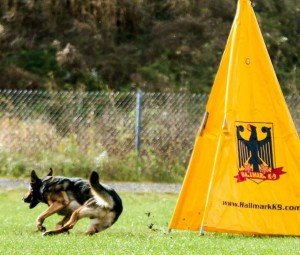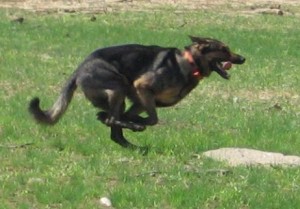Back Matters
 Back injuries are one of the top issues seen in active German Shepherd Dogs. This is, in part, because the breed standard calls for a dog that is slightly longer than tall; this creates the characteristic German Shepherd look, builds the proper trotting movement and reach, and allows the GSD to be an all-around, versatile athlete with stamina, speed, and athleticism. However, the longer back does predispose the GSD to strains, sprains, and subluxations along the spine.
Back injuries are one of the top issues seen in active German Shepherd Dogs. This is, in part, because the breed standard calls for a dog that is slightly longer than tall; this creates the characteristic German Shepherd look, builds the proper trotting movement and reach, and allows the GSD to be an all-around, versatile athlete with stamina, speed, and athleticism. However, the longer back does predispose the GSD to strains, sprains, and subluxations along the spine.
Over the next several blogs, we will examine the canine back, the issues facing our GSDs, and ways to help protect the back and spine from injury.
Anatomy of the Back
 The anatomy of the dog’s back and spine is a product of its genetic heritage as a carnivorous predator. The canine back is built to be strong but also flexible, allowing the dog to gallop and chase down its prey, as well as maneuver and change direction quickly. The main components of the dog’s back are its spinal cord and nerves, the vertebrae protecting the spinal cord, and the muscles and ligaments that attach to and support the spine.
The anatomy of the dog’s back and spine is a product of its genetic heritage as a carnivorous predator. The canine back is built to be strong but also flexible, allowing the dog to gallop and chase down its prey, as well as maneuver and change direction quickly. The main components of the dog’s back are its spinal cord and nerves, the vertebrae protecting the spinal cord, and the muscles and ligaments that attach to and support the spine.
The spinal cord runs through the center of each vertebrae; in fact, the vertebra’s primary job is to protect the spinal cord. There are intervertebral discs between each vertebra, which help maintain the proper spacing, provide cushioning, act as shock absorbers, and help make the spine capable of the many various motions it can undergo (extension, flexion, rotation, etc.). All of the information about organs in the body (such as the heart, the gastrointestinal tract, the liver, the lungs, etc.) is sent through spinal nerves that branch out from the spinal cord by passing through small spaces the vertebrae. These spinal nerves are responsible for transmitting all of the messages from the body to the brain and back again.
 The spine itself of has four different regions: cervical (neck), thoracic (mid-back), lumbar (lower back), and sacral (pelvic). There are seven cervical vertebrae that make up the neck of the dog. These then transition to the thirteen thoracic vertebrae that make up the dog’s withers and midback. The thoracic vertebrae transition to seven lumbar vertebrae, which extend from the area right behind the dog’s last ribs to the pelvis. Then there are three sacral vertebrae that cover the distance of the pelvis. The dog’s tail consists of additional vertebrae known as the coccygeal vertebrae (similar to the coccyx, or tailbone, in humans, except that the dog actually has individual vertebrae). These can vary in number based on breed.
The spine itself of has four different regions: cervical (neck), thoracic (mid-back), lumbar (lower back), and sacral (pelvic). There are seven cervical vertebrae that make up the neck of the dog. These then transition to the thirteen thoracic vertebrae that make up the dog’s withers and midback. The thoracic vertebrae transition to seven lumbar vertebrae, which extend from the area right behind the dog’s last ribs to the pelvis. Then there are three sacral vertebrae that cover the distance of the pelvis. The dog’s tail consists of additional vertebrae known as the coccygeal vertebrae (similar to the coccyx, or tailbone, in humans, except that the dog actually has individual vertebrae). These can vary in number based on breed.
Muscle Support
The dog’s spine is supported by multiple muscle groups. For example, the mid- and lower back of the dog is supported by the longissimus dorsi muscles (which run parallel to the spine along the dog’s back), iliocostalis, latissimus dorsi, and gluteal muscles. This part of the spine helps act as the suspension system for the dog. This muscular support is essential for maintaining a strong, stable back.
The core of the dog is perhaps the most crucial area supporting the spine, particularly the lumbar region. The dog’s core consists of his rectus abdominus, transversus abdominus, and external oblique muscles; these serve to support the weakest part of the spine: from the thoracolumbar junction (TL junction) to the lumbosacral junction (LS junction). These areas happen to be the areas at greatest risk for injury in our working dogs. This is because the TL junction and LS junction are both transitional points, where the vertebrae transition from one type to another. These areas also experience a lot of flexion, and are prone to arthritis and “bridging” from spondylosis as the dog ages.
 In fact, some naturopathic vets implicate impingement of the TL junction in increasing the risk of bloat in dogs, as this is where some of the nerves for the digestive tract leave and enter the spine. Because the lumbar area of the spine (which is bounded by these two junctions) is essentially in suspension and only supported by the dog’s musculature, this area is a common site for injuries and subluxations. There are also several genetic spinal conditions that affect this area as well.
In fact, some naturopathic vets implicate impingement of the TL junction in increasing the risk of bloat in dogs, as this is where some of the nerves for the digestive tract leave and enter the spine. Because the lumbar area of the spine (which is bounded by these two junctions) is essentially in suspension and only supported by the dog’s musculature, this area is a common site for injuries and subluxations. There are also several genetic spinal conditions that affect this area as well.
Join us next blog as we dive into back issues commonly seen in German Shepherd Dogs, including transitional vertebra, subluxations, degenerative myelopathy, cauda equina, and even iliopsoas tears.

